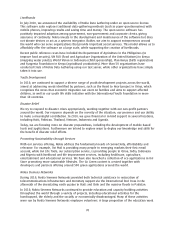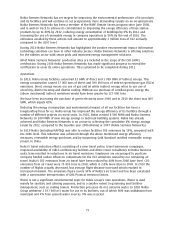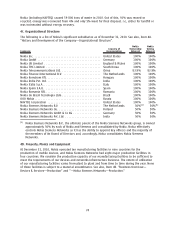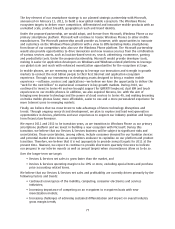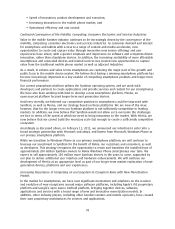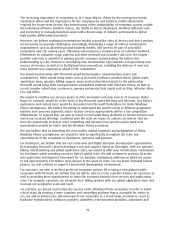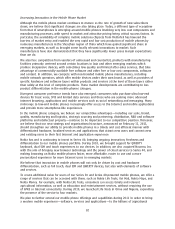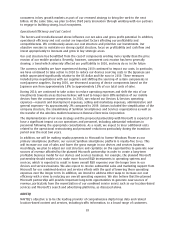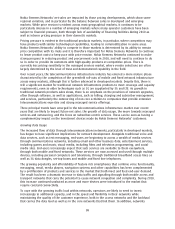Nokia 2010 Annual Report Download - page 80
Download and view the complete annual report
Please find page 80 of the 2010 Nokia annual report below. You can navigate through the pages in the report by either clicking on the pages listed below, or by using the keyword search tool below to find specific information within the annual report.The increasing importance of ecosystems is, to a large degree, driven by the convergence trends
mentioned above and the implications for the competencies and business model adjustments
required for longerterm success. Key determinants of the sustainability of ecosystem success include
the underlying software platform choices, the ability to attract developers, building sufficient scale
and partnering in mutually beneficial ways with a broad range of industry participants to deliver
highquality, differentiated products.
Moreover, we believe traditional monetization models around the sales of devices and direct services
are becoming increasingly challenging. Accordingly, developing a range of indirect monetization
opportunities, such as advertising based business models, will need to be part of successful
ecosystems over the coming years. Obtaining and analyzing a complex array of customer feedback,
information on consumer usage patterns and other personal and consumer data over the largest
possible userbase is essential in gaining greater consumer understanding. We believe this
understanding is a key element in developing new monetization opportunities and generating new
sources of revenue, as well as in facilitating future innovations, including the delivery of new and
more relevant user experiences ahead of the competition.
Our planned partnership with Microsoft would bring together complementary assets and
competencies. Nokia would bring assets such as its brand, hardware, productization, global reach,
application store, operator billing support, maps and locationbased assets to the partnership.
Microsoft would bring their next generation smartphone platform with Windows Phone, as well as
search, broader advertising, ecommerce, gaming and productivity assets such as Bing, AdCenter, Xbox
Live and Office.
We intend to combine our services assets to drive innovation and new sources of revenues. Nokia
Maps, for example, would be at the heart of key Microsoft assets like Bing and AdCenter, and Nokia’s
application and content store would be integrated into Microsoft Marketplace for Nokia Windows
Phone smartphones. We believe the ability to understand the specific needs of different geographic
markets and consumer segments and to localize services appropriately will be a key competitive
differentiator. To support this, we plan to invest in local advertising platforms to further enhance and
enrich our localized offerings. Combined with the scale we expect to achieve, we believe that we
have the opportunity to deliver more compelling and relevant local services and to build new
monetization models for Nokia and the Windows Phone ecosystem.
We also believe that by extending the price points, market segments and geographies of Nokia
Windows Phone smartphones, we should be able to significantly strengthen the scale and
attractiveness of the ecosystem to developers, operators and partners.
For developers, we believe that we can create new and highly attractive monetization opportunities.
By leveraging Microsoft’s proven developer tools and support, based on Silverlight, with our operator
billing, merchandising and global application store, we intend to offer new monetization mechanisms
for developers while providing access to Nokia’s global scale. We will continue to promote Qt as the
sole application development framework for our Symbian smartphone platform on which we expect
to sell approximately 150 million more devices in the years to come. For our Series 40based feature
phones, we will continue to support a Javabased development environment.
For operators, we plan to be their preferred ecosystem partner. By creating a new global mobile
ecosystem with Microsoft, we believe that we will be able to create a greater balance for operators as
well as providing more opportunities to share the economic benefits from services and applications
sales. For example, operators can integrate their billing systems with our global application store and
leverage our geographic scale and reach.
For partners, we intend to prioritize the success of the Windows Phone ecosystem in order to build
critical mass. By creating a more complete and compelling platform that is accessible for others to
use, we aim to enhance the attractiveness of our ecosystem to a broad range of partners—such as
hardware manufacturers, software providers, publishers, entertainment providers, advertisers and
79



